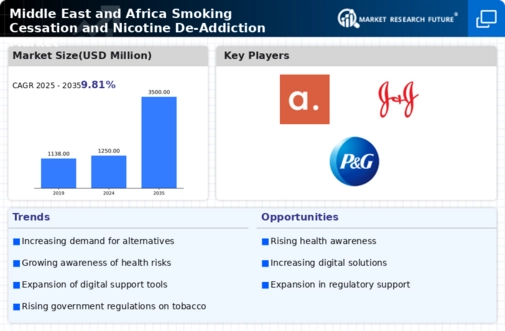Market Share
MEA Smoking Cessation Nicotine De-Addiction Market Share Analysis
The MEA landscape is rapidly changing for the Middle East and Africa, and in order to defend or improve their position in the market shares, companies are adopting various strategies. The recognition of smoking’s health hazards has led to a rise in demand for products that help individuals stop smoking as well as those that de-addict one from nicotine. Firms operating in this region are aligning themselves strategically to grab large portions of this growing market.
One of these strategies involves product expansion and innovation. Companies have come to face the reality that they need to provide a wide range of quitting aids so as to cater for different needs along the quitting process. Therefore, through this approach businesses can attract customers from across all walks of life who may have varied requirements while trying to overcome their addiction to nicotine. In fact, they are now concentrating on nicotine replacement therapy or prescription medication which suits the preferences and health conditions of people living within MEA.
In addition, strategic collaborations and partnerships have become instrumental for maintaining competitiveness among firms. For instance, there have been cases whereby businesses entered into agreements with healthcare practitioners, drug distributors or governments in a bid to bolster presence in different markets. With regard to smoking cessation products through collaboration with medical professionals help make them more accessible besides facilitating customization using insights from experts on medicine. Furthermore, working together with regulators ensures conformity with regional healthcare standards hence raising consumer trust as well as easing entry into new markets.
Companies are also opening up online platforms due to increased digitalization of health care that allow them reach out a larger number of people. Besides being an easy access point for consumers seeking information on smoking cessation products or any other information regarding them such as discounts or offers hence enabling informed choices among consumers; digital marketing and e-commerce channels assist spreading awareness about benefits related with their items through targeted marketing campaigns using online means like social media platforms plus providing educative information about these products. This creates customer awareness and keeps pace with the target market in real time alongside facilitating consumer education.
Finally, pricing and affordability strategies are key to capturing market share. Because of the wide economic disparities within the region, firms have adopted flexible prices that suit different income ranges across MEA. By making it cheap for a larger people due to competitive prices, discounts or promotions packages, smoking cessation products get into their hands. In order for companies operating in the MEA Smoking Cessation and Nicotine De-Addiction market space to create a strong position, they must ensure that they balance affordability with product quality.”














Leave a Comment